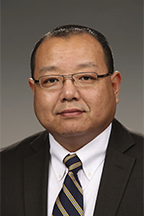Title: Development of MnBi Based Permanent Magnet
Speaker: Jun Cui, Senior Scientist, The Ames Laboratory; Associate Professor, Iowa State Materials Science
Abstract: The metallic compound MnBi is a promising rare-earth-free permanent magnet material because of its high intrinsic coercivity (Hci) and its large positive temperature coefficient [ ]. However, the desired MnBi low temperature phase (LTP) is difficult to obtain. The reaction between Mn and Bi is peritectic, so Mn tends to precipitate out of the MnBi liquid during the solidification process [ ]. In addition, MnBi LTP decomposes at ~535 K, making the conventional sintering or warm compaction methods of fabricating bulk magnets difficult. Moreover, the MnBi LTP has relatively low saturation magnetization (84 emu/g, 9 kG), which limits the theoretical maximum energy product to about 20 MGOe [ ]. Supported by the DOE ARPAe REACT program, a large group of scientists from 12 organizations has been working together on these obstacles in the past three years. This talk will give details of each challenge, the approaches used to solve it, and the current status. Some of the highlights are the alloy with 55 at.% Mn exhibits the highest LTP MnBi content (~93 wt.%), and its magnetization is 74 emu/g with 9 T applied field at 300 K. After alignment, the energy product of the powder reached 12.1 MGOe, and that of the sintered bulk magnet reached 8.6 MGOe at room temperature. In addition to synthesizing single-phase material, MnBi-Co core-shell particles were synthesized using a colloidal synthesis method. The Co layer can be controlled to ~20 nm and the overall magnetization exceeded 80 emu/g.
Speaker Bio: Dr. Cui obtained his Ph.D. degree from the Univ. of Minnesota in 2002. His thesis work focused on ferromagnetic shape memory alloy FePd. Afterward, He joined Dr. Wuttig’s group at the University of Maryland and started his long-term effort on combinatorial alloy development. It is during that period of time, he completed the work on using geometric nonlinear theory of martensite to develop extremely low hysteresis shape memory alloys. That work opened a new research area. His paper was published on Nature Materials, and was cited over 200 times to date.
In 2005, Dr. Cui joined GE Global Research Center in up-state New York. In the next 5 years, he was assigned to a wide variety of research topics that were of GE’s business interest. Examples include Sodium battery for GE Energy, NOx sensing for GE Sensing, CZT radiation detector for GE healthcare, Fuel Cell emergency backup power for GE Aviation, Magnetocaloric refrigeration for GE Appliance, etc.
In 2010, Dr. Cui joined Pacific Northwest National Laboratory. He established four new research areas for the laboratory including Magnetocaloric gas liquefaction, thermoelastic refrigeration, non-rare earth permanent magnet, and far-from-equilibrium consolidation of nanostructured bulk materials for soft magnetic and structural materials.
In 2015, Dr. Cui joined Ames Laboratory and Materials Science Department at the Iowa Stated University. He plans to extend Ames lab’s research area to soft magnetic materials and establish high throughput alloy development capacity for the materials science department at ISU.
